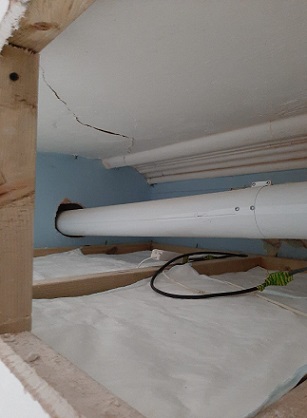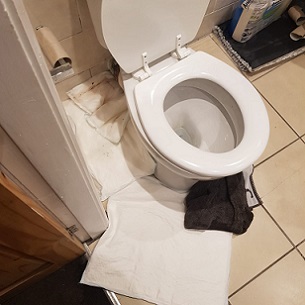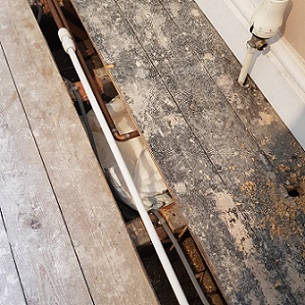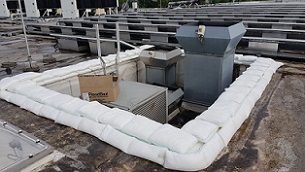
FloodSax are ideal for soaking up leaks and drips beneath pipes such as this one leading from a central heating boiler

These FloodSax saved the homeowner thousands of pounds damage when an old lead pipe gave way

FloodSax are so slim and flexible you can squeeze them into the hardest-to-reach places in homes and businesses to soak up leaks until a plumber can get there

FloodSax protected this commercial building after a faulty air conditioning system sparked a major flooding scare
Why FloodSax alternative sandbags are essential to soak up leaks, floods and escapes of water inside homes and businesses
FloodSax are now extensively used indoors to soak up leaks, spills and floods.
The absorbent technology within FloodSax means they are as useful in their ‘dry’ state as they are when soaked in water to turn them into alternative sandbags.
FloodSax (which are also known as floodbags or floodsacks) resemble large pillowcases before they come into contact with water and are ultra-thin which means they can be slipped into the most inaccessible places around homes and businesses to soak up water leaks.
They have a large surface area which means drips and leaks can fall onto the material which then absorbs it, stopping it from leaking any further.
Facilities managers use them in commercial buildings to deal with leaking roofs, pipes and radiators and many plumbers now carry them as an essential part of their kit.
FloodSax are also an early warning system for drips and leaks that could worsen to become a major flooding problem causing potentially tens of thousands of pounds damage. If you suspect a leak or drip then pop a FloodSax underneath it and leave it for a day or two.
They are white so if there is a slight leak the tell-tale signs of a watermark on the FloodSax or the FloodSax itself slightly rising would indicate there is a problem that needs sorting.
This helped a plumber stop thousands of pounds damage at a house he was working on. Plumber James Lucks from Huddersfield, West Yorkshire was called to a house where a toilet was leaking from a corroded old lead pipe. He put FloodSax around the toilet and across the bathroom floor just in case the leak worsened … and it did in a massive way.
For the seal suddenly gave way, sending gallons of water gushing across the bathroom floor.
James said: “The FloodSax not only saved the day but the customer an awful lot of money in damage. The FloodSax soaked the water up which meant it didn’t penetrate the floor and leak through to the ceiling below. If the water had gone straight onto the floor it would have been a ceiling breaker for sure.”
For more on how FloodSax can prevent internal damage caused by plumbing problems please click here.
FloodSax are now used by facilities management companies worldwide to deal with large scale spills inside buildings and several were deployed to stop a major flood inside a hospital in the USA which saved thousands of dollars in damage.
In Belgium, a row of FloodSax were placed around a faulty air conditioning system on the roof of a radio station’s building which prevented water getting in and seeping through ceilings which would have caused a colossal amount of damage inside.
When it comes to protecting homes, Christine Butler from Gloucestershire has ‘flood-proofed’ her flat with FloodSax after a leak from a neighbouring flat badly damaged her ceiling. She has slipped FloodSax beneath anywhere there are pipes or appliances that could cause a leak such as the bath, boiler and under the kitchen sink.
Christine said: “I’ve popped a FloodSax under any place in the flat where there could be a potential leak in the future. Once you have a leak which causes damage it’s such a hassle sorting out all the insurance which is why it’s best to prevent it in the first place.
“It also means that if water leaked into my flat from neighbouring flats the FloodSax would soak it up and minimise the damage.”
Christine added: “The FloodSax is like an early warning system which gives people valuable time to sort a plumber out before it deteriorates and that’s why I have them under anywhere which could cause a flooding problem.”
FloodSax managing director Richard Bailey said: “The clever way Christine is using FloodSax is exactly how they should be used indoors for flood prevention. If there is a slight leak the mark will show up on the white material, giving people time to sort the problem out before it develops into a flooding disaster.”
An 80-year lady in Wales, Anne, uses FloodSax to soak up water bubbling into her cottage from a spring running beneath it … and she also uses FloodSax as sandless sandbags to stop water getting in from a river that overflows next to her home along with water that cascades down a mountain.
Anne said: “I just couldn’t lift sandbags as they are way too heavy. I put FloodSax against the steps in the hallway and by the door to soak up any floodwater so they don’t usually fully expand before I move them which makes them so manageable. I even pop one over the drain in the downstairs shower room in case water backs up through there.”
* If you have used FloodSax inside your home or business then please let us know what you used them for and how well they worked for you. Email info@edslimited.co.uk